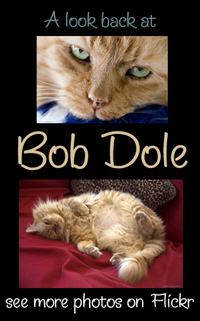
You are here
Know the Signs of Feline Diabetes #PetHealthMonth
Is this your cat?
Increased thirst, urination or possibly inappropriately urinating, hunger, weight loss, lethargy, vomiting, and even weakness in the back legs might be the warning signs your cat has Feline Diabetes Mellitus.
As with any behavior change in your cat, your first thought should be to consider taking him or her to the vet for a checkup-especially if it’s been some time since your cat has seen the vet. The symptoms listed above can also be attributed to other diseases which is why it’s even more important to have your cat examined if something is off in their behavior.

©2001 Robin A.F. Olson. Squeegee.
In honor or Pet Health Awareness month I’ve decided to share a personal story about how a cat with diabetes changed my life and how it started me on a path I hope will help others keep their cats from ever becoming “sugar cats.”
Her name was Squeegee and she was a chubby, calico/tabby mix with white mittens and brilliant green eyes. Back in the late 1990’s I didn’t know much about cat health, but I did make sure my cats got to the vet every so often. One day I came home from work and Squeegee wasn’t walking right. Her back legs were wobbly as if she could no longer hold up her own weight. Panicked, I called my vet and was able to bring her to him right away.
Dr. Larry did a careful exam and drew some blood to test. He returned to the exam room with a look on his face I’ve come to dread. He told me that Squeegee likely had neuropathy in her back legs due to having uncontrolled diabetes.
He’d have to do what’s called a glucose curve on her to make certain that was the problem (some cats can spike a high blood glucose level from the stress of going to the vet) and that I’d have to start giving Squeegee insulin shots every day for the rest of her life. Her legs would regain strength once her levels were stable, but I’d also have to change her diet to a prescription food made just for diabetic cats.
I was in a state of shock. There was no way I could deal with a cat who needed shots. I wasn’t a nurse. I just loved my cat, fed her, gave her a safe home and now I had to fuss around with her and give her food that my other cat, Stanley couldn’t eat. In a way I was glad to leave Squeegee for the night so I could try to get my mind around what was about to happen and how it would change both of our lives. Dr. Larry gave me some syringes and had me practice giving shots on an orange. Meanwhile I was trying to figure out how I was going to manage keeping her insulin shots on schedule when I worked far from home.

©2001 Robin A.F. Olson. Squeegee & Stanley enjoying a snack of cat grass.
Looking back on it I wish I could have reached through time to tell myself not to blindly listen to what I was being told. Squeegee had been free-fed dry food and got treats of canned food for most of her life. I know the poor quality food was the culprit that made her sick but I bought into the marketing schemes to get me to buy something I thought was good. I had know idea how important the role of diet was in preventing diabetes in the first place.
I began to do some research on feline diet. As I learned about cat nutrition I came to understand that the biggest thing I could do to keep my cat from getting sick in the first place was to stop free-feeding and stop feeding kibble. The answers were few and far between back then and the commercially available choices were limited. By the time I discovered that some people were putting their cats into lifetime remission by feeding them a high protein diet, Squeegee had also developed cancer which was spreading to her lungs and it was too late to help her.
Squeegee died at the age of 13, which I consider young for a cat. Had I understood what her body really needed for fuel, she could have lived a much longer, healthier life. After Squeegee passed away I stopped feeding kibble to my cats and never looked back. No cat parent should ever have to face the heartache of seeing their cat suffer needlessly when an appropriate diet might have been the answer all along.
Today there are numerous resources for anyone who is either concerned about preventing diabetes or who has a diabetic cat and needs more answers.
There’s a great organization called Diabetic Cats in Need (DCIN). DCIN supports diabetic cats in their original, adoptive, shelter, and rescue homes when finances are a barrier to treatment; helps to re-home unwanted diabetic cats by promoting cats that need homes and helps to educate caregivers on the appropriate treatment of diabetic cats by referring them to other sites.

DCINs Facebook Page
DCIN is an Internet-based rescue/assistance program. It does not have a facility or take diabetic cats into foster care. But having a Facebook following of over 4500 people, DCIN gives people who need to re-home diabetic cats a broad audience of potential adopters. When finances or distance are a barrier to re-homing in a qualified home or shelter/rescue, DCIN may be able to help pay for transport and with transport logistics.
Venita Wood, Director of DCIN said; “After insulin, the first best thing you can do to keep your diabetic cat safe and healthy is home-testing its blood glucose levels. It will cost you less to use an inexpensive human glucometer at home three to four times a day than it would cost take your cat to the veterinarian once a month for a blood glucose curve. And you will get more realistic blood glucose numbers because the cat won't be subject to vet stress.”
While DCIN does not provide guidance on the day-to-day treatment of diabetic cats because they feel other web sites are already doing a great job (see ones listed below), DCIN wants others to understand that diabetes is NOT a death sentence. They’re working hard to change the mindset of shelters and owners who feel it’s too much cost and too much hassle to keep diabetic cats alive.
From my experience I’d add that there’s no substitute for a great, wholesome diet whether your cat is diabetic or not. Should your cat become diabetic keep the faith and don’t give up. Here are some resources to help.
Feline Diabetes
Feline Nutrition
UPDATE: As of this writing I learned the sad news that Venita Wood can no longer continue to be at the helm of DCIN. She is looking for a dedicated, compassionate person to hand over the reins of this life-saving organization. If you share a passion for helping diabetic cats and you’d like to know more visit DCIN’s facebook page or contact Venita@dcin.info
==================================
This post is sponsored by BlogPaws. I am being compensated for helping spread the word about #PetHealthAwareness, but Covered in Cat Hair only shares information we feel is relevant to our readers. BlogPaws is not responsible for the content of this article.


















Comments
Well said!
Robin, thank you for sharing Squeegee's story and for letting people know the critically important role that diet can play in the lives of our cats. This is such an important message - and you told it so very well.
Add new comment